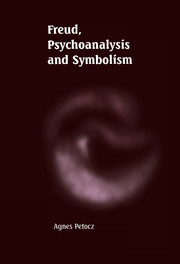Book contents
- Frontmatter
- Contents
- List of figures
- Preface
- Introduction
- Part One Exegesis and Extraction
- 1 From disorder towards the focus of inquiry
- 2 The ‘Freudian Narrow’ (FN) theory of symbolism
- 3 The ‘symbol’ in Freud's early writings (1893–1899)
- 4 Continuation and elaboration (1900–1913)
- 5 The ‘core years’ for the FN theory (1914–1917)
- 6 The treatment of symbolism in Freud's later writings (1918–1940)
- Part Two Consolidation and Defence
- Epilogue
- List of references
- Index
1 - From disorder towards the focus of inquiry
Published online by Cambridge University Press: 22 October 2009
- Frontmatter
- Contents
- List of figures
- Preface
- Introduction
- Part One Exegesis and Extraction
- 1 From disorder towards the focus of inquiry
- 2 The ‘Freudian Narrow’ (FN) theory of symbolism
- 3 The ‘symbol’ in Freud's early writings (1893–1899)
- 4 Continuation and elaboration (1900–1913)
- 5 The ‘core years’ for the FN theory (1914–1917)
- 6 The treatment of symbolism in Freud's later writings (1918–1940)
- Part Two Consolidation and Defence
- Epilogue
- List of references
- Index
Summary
The problem of definition
‘There is something very curious in semantics’, says Lévi-Strauss (1978), ‘that the word “meaning” is, probably, in the whole language, the word the meaning of which is the most difficult to define’ (p. 12). Perhaps because of its intimate connection with the concept of meaning, the term ‘symbol’, despite an extensive literature devoted to the subject, is almost as difficult. Derived from the Greek verb συμβάγγειν(literally, ‘to throw together’), the noun σύμβογον (a ‘tally’) referred originally to each of the two corresponding pieces of some small object which contracting parties broke between them and kept as proof of identity (Liddell and Scott 1968). That meaning subsequently expanded to include a diversity of meanings (other kinds of token, seal, contract, sign, code, etc.), which today has mushroomed even further. Many contemporary definitions reflect the mystique originally associated with symbols, and which prompted Whitehead (1927) to comment on the ‘unstable mixture of attraction and repulsion’ (p. 60) in our attitude towards symbolism. But the most frequent observation is that it is impossible to find a general, unifying definition.
- Type
- Chapter
- Information
- Freud, Psychoanalysis and Symbolism , pp. 9 - 20Publisher: Cambridge University PressPrint publication year: 1999



